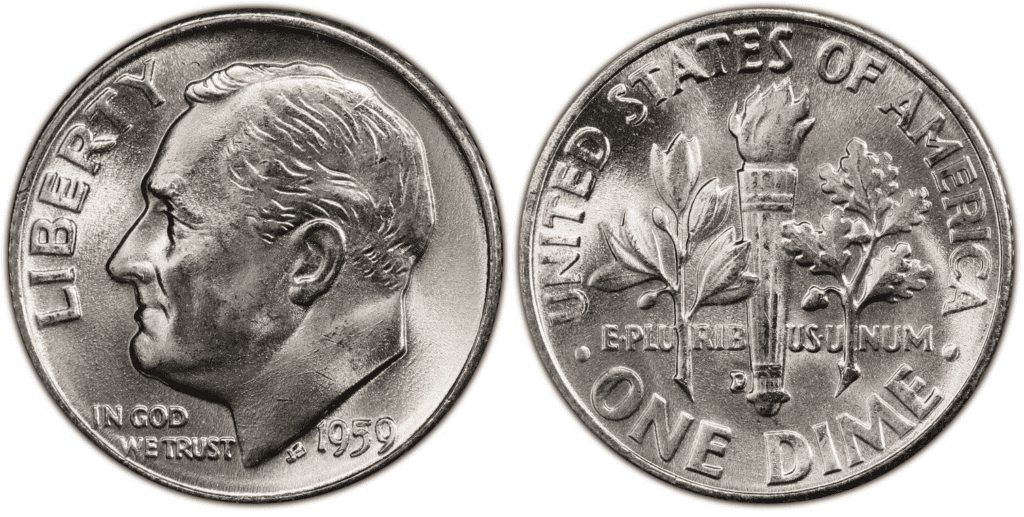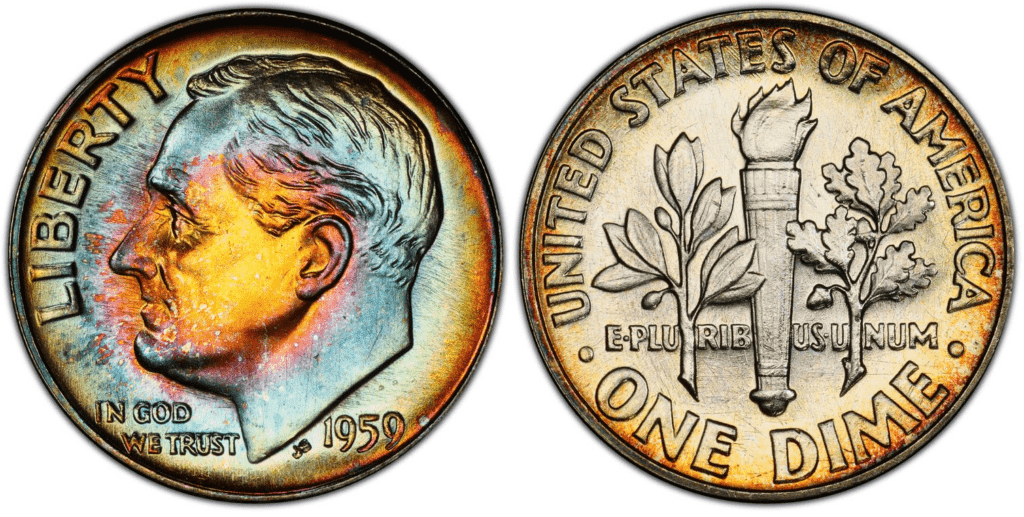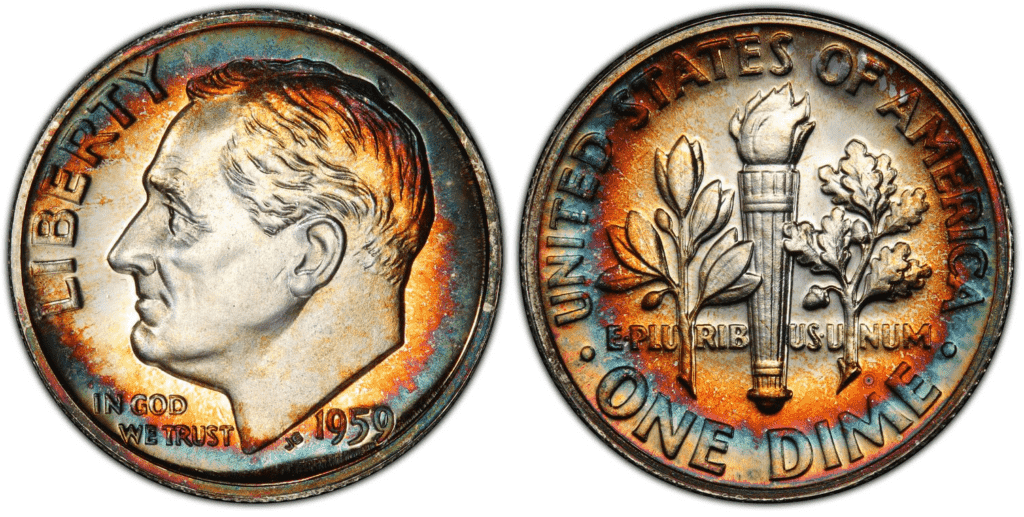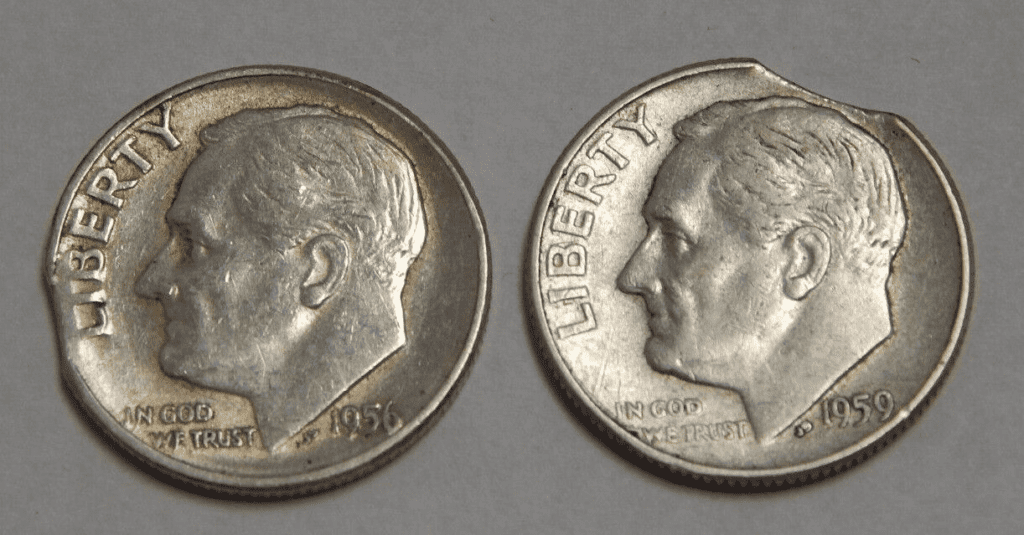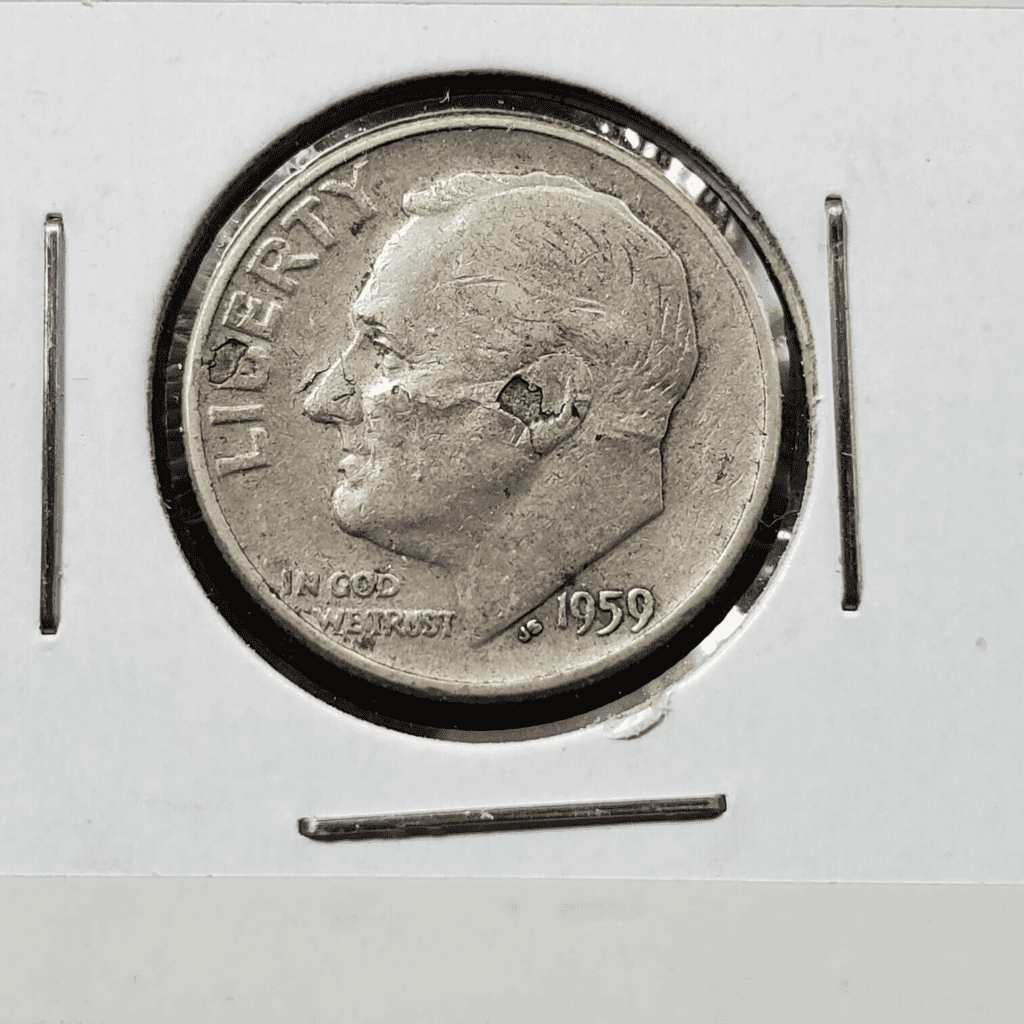What Is the 1959 Roosevelt Dime Made Of?
The 1959 Roosevelt dime is composed of 90% silver and 10% copper. The same composition was used for the Roosevelt dimes from 1946 until 1965, when the dime was turned into cupronickel according to the Coinage Act of 1965.
Nevertheless, the U.S. Mint once again produced silver Roosevelt dime from 1992 to 2018. Only this time, the silver dimes were made for collectors and not for general circulation.
The 1959 Roosevelt dime has the following specifications:
- Value – 10 cents
- Diameter – 17.91 mm
- Mass – 2.50 g
- Edge – reeded
The dime or 10-cent coin was first issued after the Coinage Act of 1792 was enacted. Today, the dime is considered to be the smallest U.S. coin in terms of thickness and diameter.
Regarding its design, the obverse (head) features the left profile of Franklin Delano Roosevelt, commonly referred to as FDR. He is the 32nd president of the United States. He died in 1945, and from there, Congress moved to add his image to the dime coin.
The designer of the original look of the Roosevelt dime was John Sinnock, the chief engraver of the US Mint at that time. Sinnock’s design wasn’t accepted immediately. In fact, he needed to change the design multiple times until the Commission of Fine Arts approved the final version. From there, the design of Sinnock remained essentially the same to this day.

photo source: USA Coin Book
The coin’s obverse features Roosevelt’s image. The inscriptions include the following:
- LIBERTY
- IN GOD WE TRUST
- 1959
- Designer’s initials (JS)
On the reverse side, there are three primary images that you’ll find the following:
- Liberty torch – represents freedom
- Olive branch – represents peace
- Oak branch – represents strength
The inscriptions include the following:
- UNITED STATES oF AMERICA
- E PLURIBUS UNUM
- ONE DIME
The word dime came from the Old French word, disme, which became dime in Modern French. The word means tithe or tenth part.
Although the Roosevelt dime was issued in 1946, the dime has been around longer than that. The dime was first issued in 1796, and at that time, it had the Draped Bust design until 1807. After that, other designs followed, which included the Capped Bust (1809 to 1837), Seated Liberty (1837 to 1891), Barber (1892 to 1916), and Winged Liberty Head (1916 to 1945).
1959 Roosevelt Dime Varieties
The 1959 Roosevelt dime has at least three varieties. These are the 1959-D, 1959-P, and 1959 Proof Roosevelt dimes. Aside from these standard-issued coins, there are also some error coins that give rise to a new variety.
To learn more, here are the 1959 Roosevelt Dime Varieties:
1959 D Roosevelt Dime
Year of minting: 1959
Mint Mark: D
Place of minting: Denver
Quantity produced: 164,919,790
Face Value: $0.10 (one cent)
Price: $0.10 to $14 (or more)
Mass: 2.50 grams
Edge: Reeded
Designer: John Sinnock
Composition: 90% Silver, 10% Copper
Diameter: 17.91 mm
Thickness: 1.35 mm

photo source: PCGS
The Denver Mint produced the most number of Roosevelt dimes in 1959, with more than 164 million issued. You can sell these coins from $0.10 to $14, depending on the rarity and condition of the coin.
1959 P Roosevelt Dime
Year of minting: 1959
Mint Mark: No mint mark
Place of minting: Philadelphia
Quantity produced: 85,780,000
Face Value: $0.10 (one cent)
Price: $0.10 to $23 (or more)
Mass: 2.50 grams
Edge: Reeded
Designer: John Sinnock
Composition: 90% Silver, 10% Copper
Diameter: 17.91 mm
Thickness: 1.35 mm

photo source: PCGS
The Philadelphia Mint produced 85,780,000 Roosevelt dimes in 1959. You can sell these coins from $0.10 to $23 or even more, especially when you sell them in the open market.
1959 dimes that are circulated are fairly common, and even other coins with grades up to MS 64. However, 1959 P dimes with a grade of MS 65 became scarcer. MS 66 and MS 67 graded dimes are available, but they are rare, and there might be a few hundred examples of them. MS 67 dimes with a Full Bands rating are the rarest. If you have one of these, you’re looking at a 10-cent coin with a thousand dollars in value.
1959 P Roosevelt Dime (Proof)
Year of minting: 1959
Mint Mark: No mint mark
Place of minting: Philadelphia
Quantity produced: 1,149,291
Face Value: $0.10 (one cent)
Price: $1 to $16 (or more)
Mass: 2.50 grams
Edge: Reeded
Designer: John Sinnock
Composition: 90% Silver, 10% Copper
Diameter: 17.91 mm
Thickness: 1.35 mm

photo source: PCGS
The Philadelphia Mint produced proof coins aside from the standard coins they issued. For proof coins of 1959 dimes, there are about 1.1 million of them.
The price starts at around $1 to $16. If you’re looking for the most valuable 1959 proof dime coins, you should keep your eyes peeled for proof coins with grades of PR69 and above. Also, look for coins with PR68 Deep Cameo or higher.
List of 1959 Roosevelt Dime Errors
There were more than 251 million 1959 Roosevelt dimes. So, it should not be surprising to see some of these coins having minting errors.
Coin errors can happen at any time during the minting process. One example is when the planchet is being cut. It should be in a perfect circle. However, the planchet may be clipped and folded.
Here’s how it looks:

photo source: eBay
Moreover, the formation of planchets can also lead to a lamination error. Here’s what it looks like:

photo source: eBay
This error happens when a foreign material gets mixed up with silver and copper. Since it’s a different material, it doesn’t properly combine with the rest of the composition. As a result, the coin may flake, crack, or separate.
Other errors happen during the striking process. You may find 1959 dimes with doubled-die reverse or doubled-die obverse errors. This happened when the planchet was hit twice. Strikes can also be weak or off-center. The die may break, and the cracks get imprinted on the coin as well.
While error coins are undesirable for the US Mint, it is highly in demand for coin collectors. After all, error coins are fun to collect because of their unique appearance and rarity.
How Much Is 1959 Roosevelt Dime Worth Today?
The 1959 Roosevelt dime is worth $0.10, which is its face value. However, since it’s made of silver, the melt value is higher, which is $1.6898. The melt value can also go up or down depending on the market value of silver.
Nevertheless, the 1959 Roosevelt dime coins can be highly valuable, especially when it has received a high grade, or it is extremely rare.
Here’s a 1959 Roosevelt Dime values chart to help you better understand the value of this coin:
| Coin | Condition | Grade | Mintage | Value |
| 1959 D Roosevelt Dime | Circulated/mint | Not graded | 164,919,790 | $0.10 to $14 |
| 1959 D Roosevelt Dime | Uncirculated/mint | MS-66 | 164,919,790 | $9 to $25 |
| 1959 D Roosevelt Dime | Uncirculated/mint | MS-67 | 164,919,790 | $23 to $55 |
| 1959 D Roosevelt Dime | Uncirculated/mint | MS-68 | 164,919,790 | $1,320 |
| 1959 no mint mark Roosevelt Dime | Circulated/mint
|
Not graded
|
85,780,000 | $0.10 to $23 |
| 1959 no mint mark Roosevelt Dime | Uncirculated/mint
|
MS-66 | 85,780,000 | $14 to $35 |
| 1959 no mint mark Roosevelt Dime | Uncirculated/mint
|
MS-67 | 85,780,000 | $110 to $180 |
| 1959 no mint mark Roosevelt Dime | Uncirculated/mint
|
MS-68 | 85,780,000 | $1,080 to $1,980 |
| 1959 no mint mark Roosevelt Dime (Proof) | Uncirculated/mint
|
Not graded
|
1,149,291 | $1 to $16 |
| 1959 no mint mark Roosevelt Dime (Proof) | Uncirculated/mint
|
PR-67 | 1,149,291 | $8 to $138 |
| 1959 no mint mark Roosevelt Dime (Proof) | Uncirculated/mint
|
PR-68 | 1,149,291 | $1 to $45 |
| 1959 no mint mark Roosevelt Dime (Proof) | Uncirculated/mint
|
PR-69 | 1,149,291 | $51 to $144 |
As you can see, there are 1959 dimes that are still worth a lot of money. Just to give you an example, according to PCGS, so far, the most expensive 1959 dime sold in an auction was a 1959 P dime with a grade of MS-67 FB. It was sold for $2,880 in August 2019 during an auction held by Heritage Auctions.
For the 1959 P, the auction record is $1,320, while for the 1959 proof dime, it’s $300.
How Does The Grading System Work?
The Sheldon Scale is used by numismatists to provide a numerical value to coins. The Sheldon Scale goes from poor (P-1) to perfect mint state (P-1) (MS-70). Coins were originally evaluated using words to reflect their condition (Good, Fair, Excellent, Etc.). Unfortunately, coin collectors and dealers had different ideas about what each of these terms represent.
Professional numismatists joined together in the 1970s and established CoinGrading standards. These numismatists now assign grades at key places on the seventy-point scale, using the most regularly utilized numeric points in conjunction with the original adjective grade. The following are the most common coin grades:
-
-
- (P-1) Poor – Indistinguishable and probably damaged; if used, must have a date and mintmark; otherwise, rather battered.
- (FR-2) Fair – Nearly smooth, but without the damage that a coin graded Poor often possesses. The coin must have enough detail to be identified.
- (G-4) Fair – Inscriptions have merged into the rims in some areas, and important elements have been mostly erased.
- (VG-8) Very Good- A little weathered, but all of the primary design elements are visible, albeit faintly. There is little if any, central detail left.
- (F-12) Good – The item is very worn, yet the wear is even, and the overall design details stand out clearly. Rims are almost completely isolated from the field.
- (VF-20) Very Fine – Moderately weathered, with some finer features still visible. The motto or all letters of LIBERTY are readable. Both sides of the coin have entire rims that are separated from the field.
- (EF-40) Extremely Fine – Gently used; all gadgets are visible, and the most important ones are bold. The finer details are bold and clear, however, light wear may be seen.
- (AU-50) Uncirculated – Slight evidence of wear on the coin’s design’s high points; may have contact marks; eye appeal should be adequate.
- (AU-58) Uncirculated Choice – Slight traces of wear, no severe contact marks, almost full mint shine, and great eye appeal.
- (MS-60) Mint State Basal – Strictly uncirculated; no indication of wear on the coin’s highest points, but an unsightly coin with reduced luster, visible contact marks, hairlines, and other flaws.
- (MS-63) Mint State Acceptable – Uncirculated, but with contact scratches and nicks, little reduced shine, but otherwise appealing appearance. The strike is weak to average.
- (MS-65) Mint State Choice – Uncirculated with great mint shine, very little contact blemishes, and exceptional eye appeal. The strike is unusually severe.
- (MS-68) Mint State Premium Quality – Uncirculated with superb luster, no obvious contact marks to the naked eye, and exceptional eye appeal. The strike is quick and appealing.
- (MS-69) Almost Perfect Mint State – Uncirculated with perfect brilliance, a sharp and appealing strike, and extremely good eye appeal. A near-perfect coin with minor imperfections in the planchet, strike, and contact markings (seen only under 8x magnification).
- (MS-70) Mint State Perfect – Under 8x magnification, there are no tiny imperfections discernible; the strike is crisp, and the coin is perfectly centered on a beautiful planchet. Rarely seen on a coin, this coin is bright and whole, with original luster and exceptional eye appeal.
-
Where To Buy Or Sell 1959 Roosevelt Dime?
The 1959 Roosevelt dime is available online and in brick-and-mortar stores. Of course, among these two options, buying online is considered to be the easiest and fastest.
However, you have to keep in mind that there are a lot of limitations when it comes to buying online. One is that you don’t actually see the product. There’s also a greater risk of scams on the Internet. That’s why you must ensure that you only work with reliable and reputable vendors.
Some of the best places where you can both buy and sell 1959 Roosevelt dimes would be Amazon and eBay. You need to open an account, and you’re ready to go.
If you choose offline buying and selling, there are coin shops, antique stores, pawnshops, and even auction houses. You can even approach coin grading service providers such as NGC and PCGS. They should be able to point you in the right direction.
FAQs
Is a 1959 dime pure silver?
The 1959 dime is not made of pure silver. Instead, it’s made of 90% silver and 10% copper.
Should I keep a 1959 dime?
Yes, you should keep a 1959 dime, especially if it is still in good condition. When the right time comes, you should be holding a more valuable dime.
Are dimes with no mint mark valuable?
The value of a dime depends on its condition and rarity.
Where is the mint mark on a 1959 dime?
The mint mark of a 1959 dime is found on the reverse side of the coin. Look for the liberty torch. Just on the left side of the tip of the torch, you should be able to find the mint mark. For the 1959 dime, the only mint mark you’ll find is D, which means that the dime was made in Denver. The Philadelphia Mint doesn’t add a mint mark.


